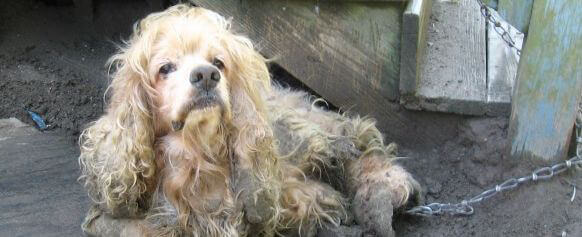|
|
|
|
||||||||
Why Chaining is Cruel
 Slide show
Slide show
Download this Q&A as PDF
- What problems does it cause to chain a dog 24/7?
Chaining is inhumane and unsafe for dogs
Dogs are social beings who thrive on interaction with people and animals. A dog kept chained for months or years suffers psychological damage. A continuously chained dog usually becomes anxious and aggressive.
Their necks can become infected from too-tight collars. Chains get tangled, strangling the dogs. They canít escape storms or attacking animals.
 Chaining
is a safety hazard for people
Chaining
is a safety hazard for people
Dogs feel protective of their territory. When confronted with a perceived threat, their fight-or-flight instinct kicks in. A chained dog, unable to flee, often feels forced to fight and will attack children or others who cross the dog's territory.
Dogs shouldnít be allowed to run loose! Dogs should be socialized and kept in the home or a fence.
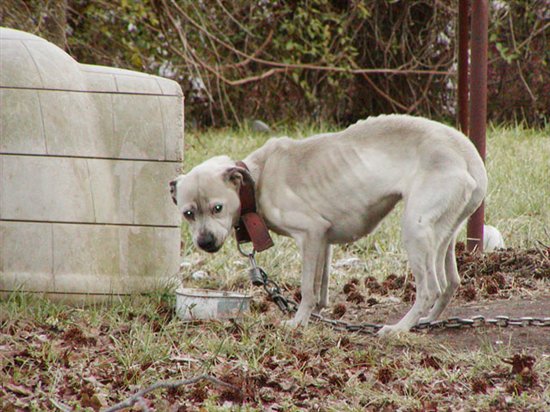
- Are tethered dogs otherwise treated well?
Rarely. They suffer from sporadic feedings, overturned water bowls, inadequate vet care, lack of exercise, and extreme temperatures. They must eat, sleep, and eliminate in one small area. Grass is beaten into hard-packed dirt. Chained dogs and are easily ignored by their owners.
- Who says chaining is inhumane?
- U.S. Department of Agriculture: "Our experience in enforcing the Animal Welfare Act has led us to conclude that continuous confinement of dogs by a tether is inhumane. A tether significantly restricts a dog's movement. A tether can also become tangled around or hooked on the dog's shelter structure or other objects, further restricting the dog's movement and potentially causing injury."
- In 1997, the USDA
ruled that people and
organizations regulated by the Animal Welfare Act cannot keep dogs
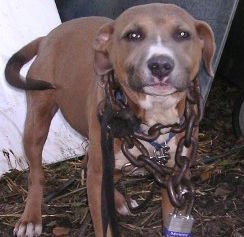 continuously
chained
continuously
chained - The American Veterinary Medical Association stated "Never tether or chain your dog because this can contribute to aggressive behavior."
- The Centers for Disease Control (CDC) concluded in a study that the dogs most likely to attack are male, unneutered, and chained.
- According to the Association of Shelter Veterinarianís Guidelines for Standards of Care in Animal Shelters, "Tethering is an unacceptable method of confinement for any animal and has no place in humane sheltering. Constant tethering of dogs in lieu of a primary enclosure is not a humane practice."
- Donít chained dogs make good guard dogs?
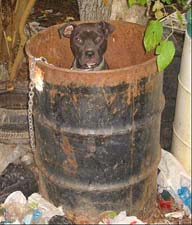
No. Chained dogs canít stop intruders. All they can do is bark. Since most chained dogs are unsocialized, they are unable to distinguish a real threat from a friend. The best guard dogs live inside the home and are part of the family, which is how K9 police dogs are raised. - Why should we pass a law to ban dog chaining?
Animal control advocates receive hundreds calls from citizens concerned about chained animals. Because chaining is legal, there is little officers can do to help. By the time it becomes a clear case of animal cruelty, it is often too late to save the dog. Prohibiting chaining makes a community safer by reducing the number of dog attacks and dog bites. A chaining law also gives officers a tool to crack down on illegal dog fighting, since most fighting dogs are kept chained. - Are there laws regulating dog chaining?
Yes, 22 states and several hundred U.S. communities have laws banning or regulating chaining. - Would a chaining law cost lots of money?
No. Animal control officers are already spending resources responding to reports of chained and neglected dogs. A ban would allow animal control officers to fine individuals in violation of the law. This would be a source of additional revenue.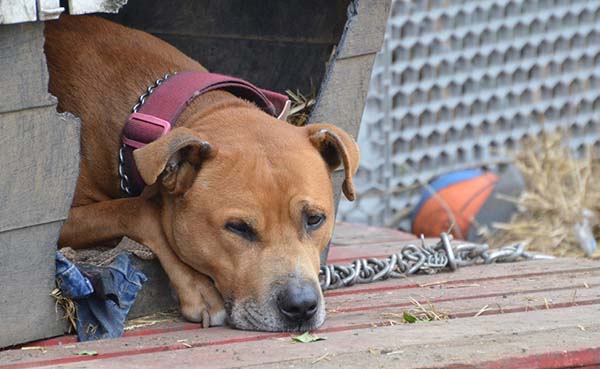
- Who would be impacted by a law to ban dog
tethering?
A law would not apply to situations where a dog is temporarily tied up, such as outside a store. People who keep their dogs continually chained would be affected by chaining bans. - What about people who canít afford a fence?
You don't have to have a fence to have a dog! Apartment-dwellers donít have private yards; their dogs are happy living inside the home with the family and going on walks. There are many resources available to help people train their dogs to be well-behaved members of the family. - What about attaching a dog's leash to a "pulley run"?
Trolleys have the same problems with fixed point chaining. More rope means more ability to get tangled and strangled, and can they can still attack anyone who come into the area.
